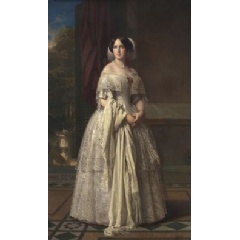The Museo del Prado is displaying Federico de Madrazo’s portrait of the Marchioness of Espeja, donated by Alicia Koplowitz
This work increases the Prado’s holdings of Federico de Madrazo to offer a complete survey of his work.
The Museo del Prado is presenting Portrait of Josefa del Águila y Ceballos, subsequently Marchioness of Espeja, donated to the Museum this April by Alicia Koplowitz, a member of the Royal Board of Trustees of the Museo del Prado. The painting is now on display in Room 62 B of the Villanueva Building.
The sitter in Madrazo’s portrait is Josefa del Águila y Ceballos Alvaredo y Álvarez de Faria (San Sebastián, 16 February 1826 – Madrid, 26 December 1888). In 1850 she married José María Narváez, 2nd Viscount of Aliatar, who two years later became the 2nd Duke of Valencia. From the date on the canvas it is known that she was 26 when the portrait was painted.
This is one of the artist’s most important works from his mature period. Dated 1852, it is recorded in the painter’s manuscript inventory as “portrait of the Viscountess of Aliatar”, the title held by the sitter at that date. The price is stated to be 12,000 reales. Madrazo returned to the work in early 1854, completing it and delivering it that year.
From the time of its inclusion in the monographic exhibition on the artist organised by the Prado in 1994, this portrait has been one of the Museum’s desired acquisitions given that the collection lacked a full-length female portrait in an outdoor setting from the 1850s, a period that corresponds to the high point of the artist’s career. Federico de Madrazo was the best Spanish portraitist of that decade and the one who achieved most international renown. During those years no other Spanish portraitist came close to the quality of his works, as evident in this example.
Characterised by its extremely elegant pose, here Madrazo offers a personal interpretation of the refined elegance made fashionable by Jean-Auguste Dominique Ingres. In addition, the pictorial treatment of the magnificent lace dress, the embroidered shawl and the feather hair ornament is of exceptional quality.
The pale tonality, from the ivory white of the shawl to the silk of the dress with the underskirt visible beneath it, is extremely delicate. Particularly remarkable is the transparent effect of the lace, its elaborate design defined with a crisp brushstroke that precisely conveys every detail. Madrazo emphasised the costly jewels worn by the sitter: a triple-strand pearl necklace, a gold brooch inset with semiprecious stones, a gold bracelet and a ring on the ring finger of her right hand, all conveyed through short, deft brushstrokes that accentuate the highlights.
Behind the staircase with a balustrade is a background of a park with tall trees and blue sky, executed with a broad brushstroke. This aristocratic setting is comparable to the one in the artist’s portrait of Leocadia Zamora y Quesada (Madrid, private collection) painted five years earlier. The success of that work must have encouraged Madrazo to repeat it. Years later, in 1858, he would paint another version of this background in his portrait of Bárbara de Bustamante y Campaner (Madrid, private collection).
( Press Release Image: https://photos.webwire.com/prmedia/6/223741/223741-1.jpg )
WebWireID223741
This news content was configured by WebWire editorial staff. Linking is permitted.
News Release Distribution and Press Release Distribution Services Provided by WebWire.
